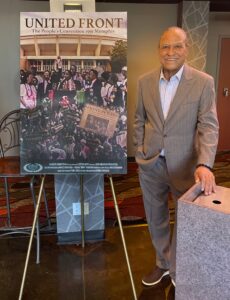Early in my career as a journalist in South Florida, I once covered a Ku Klux Klan rally.
No, seriously.
I didn’t push back against the assignment. When you’re a journalist, you want to get the story. If you’re a photojournalist, you want to get THAT SHOT — even if it means putting your safety or your life at risk. If you ever wonder why a TV reporter tries to keep rolling in the middle of a hurricane, now you know.

When I got to the rally, I wasn’t really scared, believe it or not. After all, this was 1993, not 1963. There were more people protesting the Klan than there were Klan members.
So I can’t imagine the courage it took for the legendary Ernest Withers to risk his own life and safety to get the iconic photos he did during his stunning career. And thanks to a new film by an old friend, I don’t have to.
Chuck O’Bannon’s latest documentary, “SNAP: A Look At Injustice In America,” is a powerful exploration of racial injustice through the lens of photojournalism. A free screening is set for 10 a.m. on Saturday, February 24, at the Malco Paradiso Theater in Memphis.
Renowned for his incisive storytelling and award-winning filmmaking, O’Bannon collaborates with the Withers Collection Museum and Gallery, an official site on the U.S. Civil Rights Trail, to bring this project to life.

“SNAP” is not just a documentary but a visual journey capturing the essence of Civil Rights, the Montgomery Bus Boycott, Negro League Baseball, the Memphis Sanitation Workers Strike, and more. It showcases the historic photography of Dr. Ernest C. Withers, a native Memphian whose work has been exhibited at the Smithsonian National Museum of African American History and Culture and across various international venues.
“The importance of my father’s work has been a blessing to the world and an inspiration for Human Rights supporters everywhere,” said Rosalind Withers, Ernest Withers’ daughter, who founded the Withers Collection in 2011. “SNAP allows the viewers to take a long, closeup look at what our people have endured throughout American history.”
As we gear up for the film’s public showing, I chatted with Chuck to discuss the inspiration behind this project, the challenges of capturing such a nuanced history, and the importance of preserving these vital narratives for future generations.
TSD: What was it that compelled you to create this documentary now?
Chuck O’Bannon: Well, I started with producing a virtual tour video for the Withers Collection. The museum was closed during COVID, and I realized people weren’t seeing Ernest Withers’ work. When I finished the virtual tour, I saw it should actually become a feature documentary. It covers extremely important moments in African-American history. You know, journalism, especially photojournalism in the 1950s and 1960s, dealing with civil rights and human rights was extremely dangerous.
TSD: People don’t usually think of photojournalism as dangerous work. Can you elaborate?
O’Bannon: If you can imagine 1955 in Money, Mississippi, during the trial against several European Americans for the murder of a young American of African descent (Emmitt Till), it was a perilous time. Being a photojournalist meant taking your life into your hands. Most of the events that Dr. Withers covered, from the Memphis sanitation strike onwards, were always dangerous assignments.
People don’t realize that. They just see the pictures. Well, “SNAP” shows a lot more in-depth about how he got these pictures and what he went through to get these pictures — the events he covered, the dangers he faced, and how he managed to document such significant moments in history despite these risks.
TSD: During your work on this project, did you come across anything particularly surprising?
O’Bannon: Not so much surprising, but it’s about people not looking at these photos in detail to see what they represent. The Montgomery Bus Boycott, we’ve looked at the pictures, but have we ever seen the pictures and understood how they came about?
A huge debt goes to Connor Scanlon, the scriptwriter. He’s not from Memphis and he’s of European descent. He works with the Withers Gallery, and he became so conscious of the value of these images and how they related to today’s events in civil rights, human rights. It really shows up in the film.
TSD: You had a close relationship with Dr. Withers, didn’t you?
O’Bannon: Yes, I knew him for over 30 years. He felt like part of the family. Rosalind Withers, his daughter, was the youngest in the family. His son, Teddy Withers, was a very close friend of mine. I traveled with Ernest Withers to 30 different countries in Africa. You get to really know a person in such times.
TSD: Do you feel there’s an internal voice or something guiding you in this project, perhaps something from Dr. Withers himself?
O’Bannon: Well, I would hope that this work would meet his approval. The man was truly full of love, that’s the honest truth. He loved people, loved Memphis. When we went to Africa, he would start his day buying postcards and spend hours sending them back to Memphis, sharing our journey. He said, “These are my people,” about those who may never get to make such a trip. He did this religiously.
Dr. Withers was more than a journalist or a photographer. He was a family man, a God-fearing man, who believed in documenting what he was doing. I think he knew the historic significance of his mission and purpose. It’s important to me that people remember him as the real man he was and appreciate the legacy and history he left behind.
TSD: After the initial screening, how can people see the documentary?
O’Bannon: We’re working to get it available on streaming later this spring. And if we get a good response to our Feb. 24 screening, we can arrange more live screenings in the theater.
TSD: Do you have any insights on your motivation for your work?
O’Bannon: My motivation is documenting things to live on long after I’m gone. I want the stories and the films to live on. As long as they live, then I think my living has not been in vain.
You can catch ‘SNAP’ at the Malco Paradiso Theatre on Saturday, Feb. 24 at 10 a.m. Admission is free. This showing is being facilitated by the MVP3 Foundation, a non profit 501 (3) founded by Marie Pizano, head of MVP3 Entertainment Group based in Memphis.


